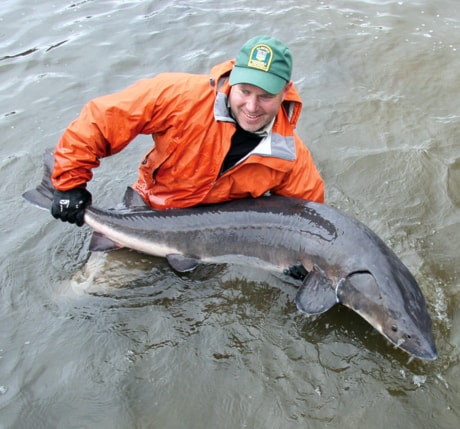As fish stories go, this sounded like a whopper.
But, hey, it was started at a golf course.
Even Alberta Fish and Wildlife senior fisheries biologist Vance Buchwald admitted to more than a little skepticism when he headed out to a pond at River Bend Golf Course on June 9 after getting a report that a huge sturgeon had been landed by a shocked angler a few days earlier.
“I mean, I went in with the attitude there was probably less than a 50 per cent chance we were going to catch it, or the story was even true,” said Buchwald from his Red Deer office on Thursday.
“We were pretty excited to catch it and relatively easily.”
What he and a Fish and Wildlife colleague caught in their gill nets amazed them — a 1.48-metre sturgeon weighing at best guess (their scale wasn’t big enough to get an accurate measurement) between 25 and 35 kg.
It took the pair of them some time to muscle the giant fish into their boat so it could be tagged and released into the Red Deer River.
“It’s one of those things,” he said. “Even though I’m a biologist, this is the first live sturgeon I’ve seen out of an aquarium.”
Sturgeon are not unknown in the Red Deer River. Sightings have been confirmed north of Drumheller, and the odd unsubstantiated sighting has come in every once in a while from as far upstream as Dickson Dam.
But to find the giant fish, which has a pedigree dating back 200 million years and has changed so little they are sometimes called living fossils, in a smallish pond on a Central Alberta golf course is pretty darn low on the probability scale.
The best guess among fish biologists is that the sturgeon found its way into the pond during a flood; the last big one was in 2005, but there have been others in the past 20 years.
Terry Clayton, a Fish and Wildlife senior fisheries biologist out of Lethbridge, is team lead for Alberta’s Lake Sturgeon Recovery Team and was surprised as anyone to hear about Red Deer’s resident sturgeon.
“They’re not very common (in the Red Deer River) and they’re not very common at all in the upper part or the part around Red Deer.”
More are found at the tail of the Red Deer River near Empress and sturgeon are mostly found in the South Saskatchewan River between the Saskatchewan border and Medicine Hat. However, Sturgeon have also been found in the North Saskatchewan, Oldman and Bow Rivers.
While Clayton can only speculate on how the sturgeon ended up in Red Deer, the flood theory makes the most sense. A lake sturgeon typically spawns in the spring and they swim upstream during peak flow in spring runoff.
“It might have gone upstream farther than it normally would.” A few sturgeon have been stranded in the past when flood waters recede. He has a photo of a large sturgeon left high and dry on a gravel bar in the Oldman River in 1995.
“This one might have been fortunate to get into an area that when the water receded, the pond was there.”
The fish has been tagged on its dorsal fin with a tag that looks like a small piece of orange spaghetti. Clayton said if the fish is caught again, anglers are asked to give Fish and Wildlife a call. Biologists will be able to gather information on its progress back downstream.
Removing the fish from the pond and releasing it into the river has a number of benefits, he said.
“It was probably pretty lonely for one, because it’s most likely the only one in there.
“It’s a valuable member of the whole spawning population in the South Saskatchewan Basin. Putting it back in the river lets it join other members of its species and take part in future spawning events.”
pcowley@www.reddeeradvocate.com
